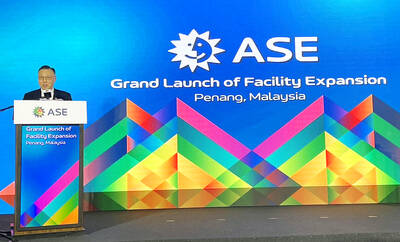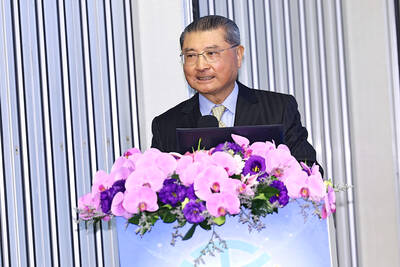Powerchip Semiconductor Manufacturing Corp (力積電) has reached an agreement with SBI Holdings Inc to jointly build a 12-inch fab in Japan to make chips for vehicles and artificial intelligence (AI) applications, the companies announced yesterday.
Powerchip is Taiwan’s third-largest contract chipmaker, after Taiwan Semiconductor Manufacturing Co (TSMC, 台積電) and United Microelectronics Corp (UMC, 聯電). SBI is a Japanese financial services provider based in Tokyo.
Under the agreement, Powerchip and SBI will initially establish a preparatory company to select a site for the planned factory, formulate business plans and establish their funding strategies.

Photo courtesy of Powerchip Semiconductor Manufacturing Corp
In a statement, Powerchip said the fab would make chips using legacy process technologies such as 22-nanometer or 28-nanometer, as well as more mature technologies.
“Our priority is Japan,” Powerchip chairman Frank Huang (黃崇仁) said, after signing the agreement with SBI chief executive officer Yoshitaka Kitao in Tokyo.
A weakening yen, lower labor costs and favorable financing now make Japan attractive as a production site, Huang said.
SBI said the new fab would aim to enhance semiconductor supply chain resilience in Japan as the issue of procuring sufficient chips — used in AI, automotive and other devices — has become critical amid heightened geopolitical risks.
“Powerchip will contribute to the stable supply of semiconductors in Japan and around the world by leveraging its expertise,” SBI said in a separate statement.
Details regarding the start of construction and operation of the plant will be announced when they become more clear, the companies said.
The partnership comes as Japan pledges to revive its semiconductor industry, after Tokyo launched its “Strategy for Semiconductors and the Digital Industry” in June 2021, SBI said.
“Partnering with Taiwan’s leading semiconductor company will be a major key to success,” SBI said.
While Japan is preparing billions of dollars in subsidies as part of a push to triple domestic chip production by 2030, such efforts are not enough, Kitao said.
“The government has spent ¥2 trillion (US$13.9 billion) over the past two years to develop domestic chip manufacturing capacity, but I think that’s too little,” Kitao said.
“We want to help revive Japan’s chip industry.” he said.
In the 1990s, Japan boasted a 50 percent share of the global semiconductor market, but its share in the global market has now dropped to less than 10 percent, SBI said. The global semiconductor market is expected to reach ¥100 trillion by 2030, the company said.
Additional reporting by Bloomberg

When an apartment comes up for rent in Germany’s big cities, hundreds of prospective tenants often queue down the street to view it, but the acute shortage of affordable housing is getting scant attention ahead of today’s snap general election. “Housing is one of the main problems for people, but nobody talks about it, nobody takes it seriously,” said Andreas Ibel, president of Build Europe, an association representing housing developers. Migration and the sluggish economy top the list of voters’ concerns, but analysts say housing policy fails to break through as returns on investment take time to register, making the

‘SILVER LINING’: Although the news caused TSMC to fall on the local market, an analyst said that as tariffs are not set to go into effect until April, there is still time for negotiations US President Donald Trump on Tuesday said that he would likely impose tariffs on semiconductor, automobile and pharmaceutical imports of about 25 percent, with an announcement coming as soon as April 2 in a move that would represent a dramatic widening of the US leader’s trade war. “I probably will tell you that on April 2, but it’ll be in the neighborhood of 25 percent,” Trump told reporters at his Mar-a-Lago club when asked about his plan for auto tariffs. Asked about similar levies on pharmaceutical drugs and semiconductors, the president said that “it’ll be 25 percent and higher, and it’ll

CHIP BOOM: Revenue for the semiconductor industry is set to reach US$1 trillion by 2032, opening up opportunities for the chip pacakging and testing company, it said ASE Technology Holding Co (日月光投控), the world’s largest provider of outsourced semiconductor assembly and test (OSAT) services, yesterday launched a new advanced manufacturing facility in Penang, Malaysia, aiming to meet growing demand for emerging technologies such as generative artificial intelligence (AI) applications. The US$300 million facility is a critical step in expanding ASE’s global footprint, offering an alternative for customers from the US, Europe, Japan, South Korea and China to assemble and test chips outside of Taiwan amid efforts to diversify supply chains. The plant, the company’s fifth in Malaysia, is part of a strategic expansion plan that would more than triple

Taiwanese artificial intelligence (AI) server makers are expected to make major investments in Texas in May after US President Donald Trump’s first 100 days in office and amid his rising tariff threats, Taiwan Electrical and Electronic Manufacturers’ Association (TEEMA, 台灣電子電機公會) chairman Richard Lee (李詩欽) said yesterday. The association led a delegation of seven AI server manufacturers to Washington, as well as the US states of California, Texas and New Mexico, to discuss land and tax issues, as Taiwanese firms speed up their production plans in the US with many of them seeing Texas as their top option for investment, Lee said. The